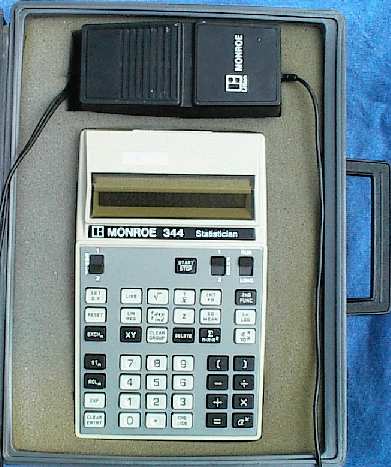
In the latter part of 1972, the Computer Design Corporation of Los Angeles, California, also known as Compucorp, began the introduction of a series of highly functional portable electronic scientific calculators that were small enough to be carried around and were battery operated. At least ten different models were made, with different types of functions but using the same basic technology and components.
These Compucorp machines measure 9" high, 5 1/8" wide, and 2 1/4" thick, and weigh approximately 3.5 pounds. The machines can be operated off of four D-size batteries - NiCad rechargeable batteries were specified but the machines could be run off of D-size alkaline batteries if necessary. An external AC power supply was included that provided approximately 1.3 Amps current at 7 Volts DC to the calculator (the manual specified, however, that the AC supply was not to be used if non-rechargeable batteries were installed in the calculator). The machines utilized a 16-digit Burroughs Panaplex II, planar orange neon-type display. A foam-lined hard case was provided to store the calculator and power supply. The Monroe calculator company also sold many of the same models under their own label. The Monroe machines had exactly the same model numbers as their Compucorp counterparts. This article covers both brand names interchangeably, as there was no difference in the machines except the labels put on them.
As of this writing I am aware of ten different models of the Compucorp 300-Series machines:
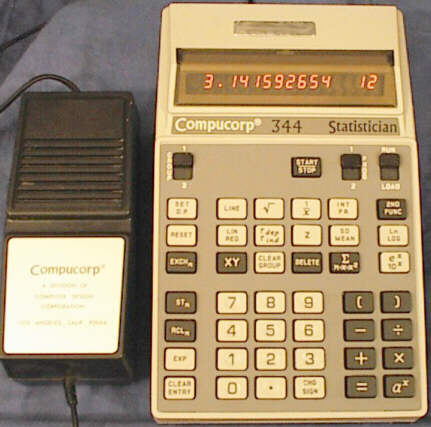
Compucorp 344 Statistician with power supply
A photograph of the model 344 Statistician calculator is shown above, along with a Compucorp AC power supply module. Following is a photograph of the machine with the Monroe label, in the foam-lined case and with a Monroe-labelled power unit, and a photograph of the rear of the unit including the quick-reference instruction label.

Monroe 344 Statistician with power supply and case
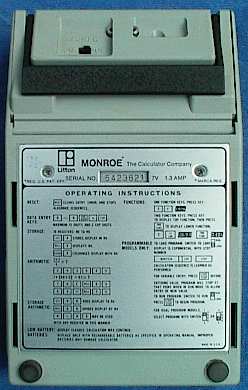
Monroe 344 Statistician back view with instruction label
The model 344 is a programmable calculator with built-in functions for statistics use. It provides all four basic arithmetic functions. It uses algebraic entry method with precedence - multiply & divide are preformed before addition and subtraction. The calculator also supports parenthesis to allow direct entry of equations, with the capability of nesting the parenthesis two deep. The "a^x" key allows raising numbers to powers. Unlike many other early scientific calculators, this function is implemented to allow negative numbers to be raised to integer powers in addition to positive numbers raised to any power. The arithmetic unit also supported automatic constant capability. While the calculator could display a 10-digit mantissa and 2-digit exponent, internally the calculator has a 13-digit capacity for the mantissa. The calculator actually allows up to 13 digits to be entered from the keyboard, although only the first 10 are displayed. Attempting to enter a 14th digit causes an error condition with "E----" displayed. The "RESET" key is used as a master clear to reset the arithmetic unit for the next calculation (like the "C" key on many other calculators), and the "CLEAR ENTRY" key simply clears the display in case an entry mistake is made but does not affect the results of a calculation in progress. The "SET D.P." key is used to set the number of digits to the right of the decimal point displayed, although all numbers are stored to full 13-digit capacity internally.
In addition to arithmetic functions, the Model 344 can perform several other scientific-type functions such as logarithms and inverse logarithms (common and natural for both functions), square root, and reciprocal. It does not have trigonometry functions. As with most Compucorp calculators, the "2ND FUNC" - second function key - was pressed after the desired operation, instead of as a prefix key like on most other manufacturers' scientific calculators. The calculator actually computed both functions when the key is pressed and displayed the answer for the primary function, then the user had to press the "2ND FUNC" key to get the result for the secondary function of the key brought into the display. Pressing the "2ND FUNC" key again would return the primary function answer to the display. A side-effect of this arrangement is that for the combined inverse log (10^x and e^x) button, the calculator indicates an error condition if an argument outside the range -99 to +99 is used, even though the valid range for e^x is from -225 to +229. In this case, while the calculator indicates an error (with the "E----" display), the correct answer to the e^x function can be found by pressing the "CLEAR RESET" and then "2ND FUNC" buttons. Another function key "INT FR" provides the integer part of the displayed number as the primary function and the fractional part of the displayed number as the second function.
The Model 344 has ten data registers, numbered 0 through 9. These registers can be directly accessed through the "STn", "RCLn", and "EXCHn" keys. "STn" followed by a number from 0-9 stores the display in the specified register number. All 13 digits of the number, plus exponent, are stored in the register. The "RCLn" key is used to recall a register's contents to the display. The "EXCHn" key is used to swap the contents of the display with the specified memory register. The calculator also supports direct register arithmetic. This feature is often first attributed to the Hewlett-Packard HP-45 calculator, however it appeared in the Compucorp calculator nearly two years earlier. Arithmetic into registers is performed by pressing the "STn" key, followed by an arithmetic key, followed by the register number. For instance, pressing "STn", "-", "0" subtracts the displayed value from Register #0. The machine also supports arithmetic out of registers, using the "RCLn" key followed by an arithmetic key, followed by the register number. Pressing "RCLn", "+", "1" adds the contents of register #1 into the displayed value.
The Model 344 is pre-programmed to handle several major functions for use by statisticians. A key to this capability is the use of the calculator's memory registers to accumulate data that is used by the statistical functions. Registers 1-6 are used by the statistics functions, with Register 0 also used by the linear regression function. For the statistics functions, two different groups of data could be kept, with the group being operated on specified by the "GROUP" switch at the top of the keyboard. When GROUP 1 is selected registers 1-3 are used by the statistics functions, and registers 4-6 are used when GROUP 2 is selected. The "CLEAR GROUP" key is used to clear the three registers for the group selected by the switch.
Three keys are used for entering data for statistics functions. The "SUM n-x-x^2" button is used to accumulate the number of entries in storage register 1 (register 4 for Group 2), the sum of the entered numbers in register 2 (register 5 for Group 2), and the sum of the squares of the entered numbers in register 3 (register 6 for group 2). In combination with the "=" key, "grouped data" can be entered - for instance, if in sample of data the same value appeared multiple times, the value is entered, the "SUM n-x-x^2" key is pressed, the multiple number is entered, and the "=" key is pressed. The "DELETE" key is used as a prefix key in case a wrong value was entered, pressing it before the "SUM n-x-x^2" key causes the value to be deleted from the appropriate registers. The "XY" key is used for storing pairs of data for the linear regression function and the "dependent t" statistic. The X value is entered first, the "XY" key pressed, then the Y value is entered and the "=" key is pressed. This stores the sum of the products of X & Y in register 0, the number of entries in registers 1 and 4, the sum of X values in register 2, the sum of the squares of the X values in register 3, the sum of Y values in register 5, and the sum of the squares of the Y values in register 6. The "DELETE" key can be used as a prefix to "XY" to correct entries. The "CLEAR GROUP" key can be used as a prefix to the "XY" key, and clears registers 0-6.
Six pre-programmed functions make use of the data accumulated using the data entry keys. The "SD MEAN" key provides the mean, or average, of the data for the selected group as the primary function, and the standard deviation of the data as the second function. The "LIN REG" key is used to calculate the coefficient of correlation (r) for linear regression analysis of the data as the primary function. The slope (m) is displayed by pressing the "2ND FUNC" key. To find the intercept (b), the zero and "LINE" keys are pressed. An estimated Y-axis value (based on the regression calculation) can be determined by entering an X value and pressing the "LINE" key. The mean and standard deviation of the X values can be calculated using the "SD MEAN" key with the group key set for group 1, and for the Y values with the group key set for group 2. The dependent t statistic (t test for correlated data) is calculated as the primary function of the "tdep tind" key for X,Y pairs of data. The independent t statistic (t test for independent means) is calculated by entering the X data values with the "SUM n-x-x^2" key with the group switch set to 1 and the Y data values with the group switch set to 2. The "tdep tind" key is pressed, followed by "2ND FUNC" to display the t(ind) function.
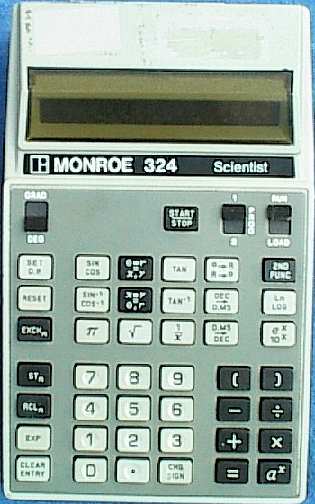
Monroe 324 Scientist
The Model 324 Scientist calculator is very similar in function to the Model 344 Statistician, except that it has a number of pre-programmed functions that are more oriented for scientific & engineering use rather than statistics. It has the same number entry mechanism, same number of memories, and same operation of the "2nd function" key as the Statistician. Instead of the statistic functions, it has the full compliment of standard trigonometric functions, along with polar-rectangular conversions and degree-radian conversions. It has a slide switch to select between degrees mode and grad mode for the trigonometric functions, but does not offer a native radians mode, offering the conversion instead. It also allows conversion between decimal degrees and degrees/minutes/seconds. A "pi" key is provided as well.
When placed in program mode, the calculator switches to a modified scientific notation display, with a seven-digit mantissa and two-digit exponent starting at the left side and a two-digit number at the far right that indicates which step of the memory is ready for loading. There were no key codes or other provisions for indicating which keys are entered into the program memory. The machine has no way to edit or modify a program, and to correct a mistake required switching to "RUN" and back to "LOAD", then re-entering all the program steps.

Monroe 326 Scientist
The Model 326 Scientist calculator is an improvement over the earlier Compucorp programmable calculators. The Model 326 allows true programming, with branching and program editing, and key code display of the steps in program memory. It is preprogrammed with logarithm and trigonometric functions, as well as some statistics capabilities such as summations and factorials. It also has a number of metric conversion factors built in. Unlike the earlier models, the Model 326 uses a "f" key as a prefix to access the second functions of the multi-function keys, instead of the post-fix "2nd func" key.
In addition, the Model 326 added the capability to store
programs on an external cassette tape drive. The Model 392
cassette drive can be attached to the Model 326 calculator
on a 25-pin connector on the lower right side of the calculator.
The memory registers in the calculator could also be stored
on cassette tape for later recall. The photograph below
shows a Model 392 tape drive.
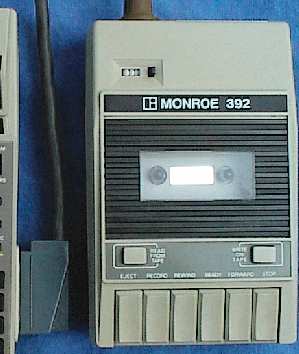
Monroe 392 Cassette Tape Drive
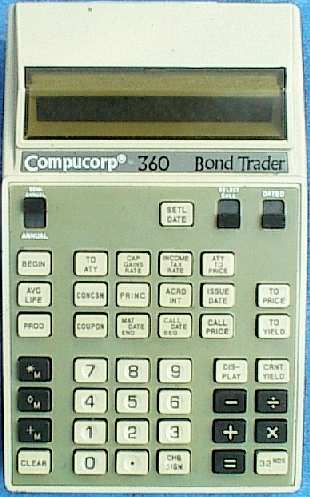
Compucorp 360 Bond Trader
A photograph of the model 360 Bond Trader calculator is shown above. This is a very specialized machine targetted for calculating information regarding bonds. It does not provide general-purpose financial functions, such as the popular HP80 financial calculator. The model 360 has a 12-digit capability for number entry and display. It does not support scientific notation. The model 360/65 appears to be basically the same unit with some added keyboard-selectable configurations. The machine has a quick-reference instruction label on the back that describes the functions of some of the specialized keys, as shown in the photograph below.

Compucorp 360 Bond Trader - back side with instruction label
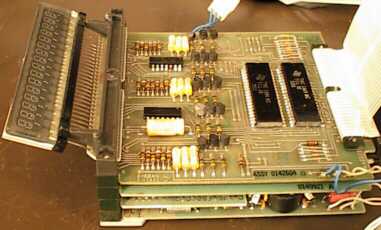
The above photo shows the internal electronics of a Compucorp 344 machine with the cover removed, and is typical of all of these machines. There are five printed-circuit boards in a "sandwich" arrangement. From the bottom, they are: power supply, Memory, Processor, Keyboard/Display interface, and display PCB. The circuit boards are connected together by an arrangement of phenolic blocks with conductive fingers that wrap around from one side of each block to the other. This arrangement provides connectivity from the card-edge connector fingers on the top of each PCB to the fingers on the bottom of the PCB above it. The top phenolic block is specialized to provide support for the Panaplex II display module, and has brass tapped inserts at each end and in the middle. Three long screws are inserted through the stack of phenolic blocks and screwed into these inserts, using this arrangement to hold the stack of PCBs together.
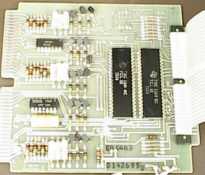
The top PCB (below the display module) is the keyboard & display interface board. This PCB for the model 360 is shown in the photo above. The PCB for the model 344 is virtually identical. The calculator's keyboard is connected to one side of the PCB by a long, wide ribbon cable. Two 40-pin Large-Scale Integration (LSI) ICs made by Texas Instruments are located next to the ribbon cable, and provide the keyboard scanning/multiplexing and display multiplexing functions. The IC closest to the ribbon cable is TI part number TMC1869NC (also marked TLC02), and is probably the keyboard scanner. The IC to the left is TI part number TMC1864NC (also marked TLC08), and is probably the display multiplexer, as the driver transistors are connected to it. A number of individual transistors are located between these ICs and the card-edge connector fingers to provide the high-voltage drive for the digit positions of the Panaplex II display module. Two 16-pin ICs are likely the segment driver devices for the display.


The two above photos show the processor board for the models 360 and 344. Both boards use four, 40-pin LSI ICs as the main processor for the calculator. From left to right in the photo, the model 360 processor board uses four Texas Instruments ICs with part numbers TMC1872NC (also marked TLC07, date code 7230), TMC1866 (also marked TLC06, date code 7233), TMC1867NC (also marked TLC05, date code 7230), and TMC1870NC (also marked TLC04, date code 7231). The PCB itself is marked with part number 0140897A. The model 344 processor board uses four ICs made by American Microsystems Incorporated (AMI), with part numbers C1816 (also marked ACL07, date code 7323), C1817 (also marked ACL06, date code 7335), C1819 (also marked ACL05, date code 7335), and C1818 (also marked ACL04, date code 7335). The PCB itself is marked with part number 0140913A. It is likely that the TI and AMI parts are identical, as second-sourcing of ICs was often a requirement during the timeframe these machines were built.


The two above photos show the memory boards for the models 360 and 344. These boards contain both the Read-Only Memory that stores the calculator's pre-programmed instructions and the Random-Access Memory that stores the calculators data registers and user-entered programs (on the 344). The Model 360 memory board has a Texas Instruments TMC1871NC (also marked TLC03, date code 7313) 40-pin IC at the top left, with three 28-pin, 8K-bit ROM ICs below. From top to bottom, they are an AMI C9522 (also marked 7710BE), a General Instruments 8KR23A (date code 7340), and a General Instruments 8KR11B (date code 7313). To the right of the ROM ICs are three 16-pin AM93L0059X devices, which are probably buffer devices. On the right side of the PCB, from top to bottom, are an Intel P2102 RAM, two Signetics 2602B, and another Intel P2102 RAM. I'm not sure if the 2602B devices are RAM or something else. At the bottom is a Texas Instruments SN74L75 dual-D flip-flop.
The model 344 memory board has an AMI C1815 (also marked ACL03 and 7328KFV) 40-pin IC at the top left, with three 28-pin 8K-bit ROM ICs below. On another Model 344 I've seen of later vintage, there is a single 8K-bit ROM and a single 16K-bit ROM. The memory board's PCB was designed to be flexable enough to handle several types of ROM ICs. From top to bottom, they are a General Instruments 8KR218, a TI TMC1864NC (also marked 8KR029, date code 7402), and a General Instruments 8KR09A (date code 7332). To the right of the ROM ICs are threee 16-pin Fairchild 93L00 devices, likely the same type of buffer devices as those on the model 360's PCB. On the right side of the PCB there are four Intel P2102 RAM devices, with a 74L75 dual-D flip-flop below.
The total amount of Read-Only Memory in these machines, 24K bits, is quite impressive for the timeframe. By comparison, the HP35 calculator, introduced in early 1972, had 7.7K bits of ROM.

The above photo shows the power supply PCB for the Model 360. The PCB for the other models is virtually identical (with the exception of the Model 326). This circuit board has several DC-DC converters to convert the battery/external supply voltage to the proper voltages needed for supplying power to the ICs, as well as a step-up converter that provides the high-voltage needed for the neon-based Panaplex II display module.